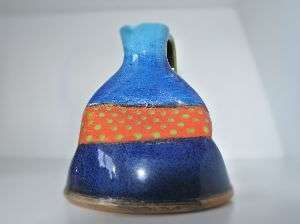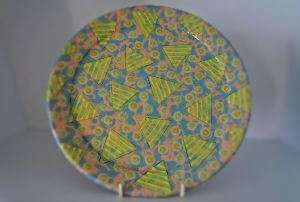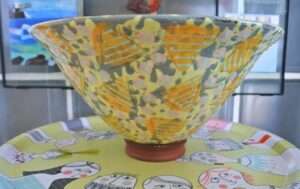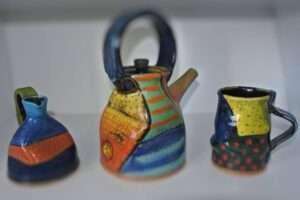John Pollex
John Pollex

We first met John Pollex in his Plymouth studio. We lived in Plymouth for a few years in the early 80’s and later on in the late 80’s. John’s Gallery was in the Barbican area of Plymouth. I met him again a few years later in 1994, I was a member of the Southern Ceramics Group. John Pollex came along to do a demonstration day for the members at a school in New Forest, Hampshire.
Artist Statement
John Pollex has carved out a unique niche in the world of studio pottery. During the 70s and early 80s, he established himself as a respected maker of traditional Slipware, before his work took a dramatic turn.
In 1984 Pollex decided to change direction. Referring to the work of painters such as Sir Howard Hodgkin, Robert Natkin, Patrick Heron and Ben Nicholson, Pollex used his knowledge and understanding of the application of slips (liquid clay) to develop a completely different style of working. He dispensed with slip trailers in favour of paintbrushes and sponges and more recently plastic spatulas. Intensely coloured earthenware slips are applied in a free and painterly abstract manner. The change seems to have been clean and dramatic and appears to owe nothing to the slipware of before.
Apart from his regard for the aforementioned painters, Pollex’s work often includes references to his interest in Zen Buddhism, in particular the immediacy of brush strokes in Zen calligraphy.

Pollex is often asked why he never paints in the conventional manner. He says that he has always been a potter who enjoys what he does and he still feels there is much more to discover in the world of ceramics. Pollex studied at Sir John Cass in Whitechapel from 1966-68; he then went on to become a Technician at Harrow College of Art during 1968-70. After Harrow, he became assistant to Bryan Newman and Colin Pearson until 1971. He moved to Plymouth in the autumn of 1971 establishing a studio and gallery in the historic Barbican area. In 2000 he moved his studio to his house where he now works.
About John Pollex

Getting Started. First published in CPA News No 101 May/June 2005, The Images are mine from our collection of ceramics.
Well for a start, it was a long time ago so I’m going to have to take a long slow stroll down memory lane, not easy with a mind map that has seen better days.
I got started in a rather unorthodox way, I was looking for what in Buddhist terms was called ‘right livelihood’. Through a mutual friend, I met a young man called Anthony Kedros who was a student on the Harrow pottery course, which was around 1966. We had much in common and seemed to be on the same spiritual wavelength. So I thought maybe I could become a Potter. I had no qualifications having left school one month after my 15th birthday, the quickest route for me to get started was to enrol somewhere as a vocational student.
So I donned my three-quarter length white Johnnie Staccato raincoat, slipped into my winkle pickers, jumped on my scooter and headed for Sir John Cass School of Art in Whitechapel. Someone pointed me in the direction of the person in charge; she asked if she could help me. I said, “Yes I’d like to be a potter”. To which she replied, “Go home and change and come back this afternoon”.
Saturdays watching Students Work

That was a big turning point in my life, I went back that afternoon and a young student showed me how to wedge clay. He roared with laughter when I innocently asked if it hurt the clay! A friend who was the ceramics technician at Camberwell. I would often go there on Saturdays and watch the students working. I remember watching one of them throwing, she paused for a moment, looked at me and said; “it’s lovely stuff isn’t it”. About this time I met Ian Godfrey, I liked his work and his approach to it.
We soon became friends and he allowed me to use his studio whenever I wanted to. Ian was a gentle and generous person; he always had time for others. Some Saturdays we would go to the Angel antiques market where he would hunt for Jade objects. I used to like watching him do this; he seemed to have mastered the art of seeing the beauty in objects that most people missed.
Technician at the Harrow Studio Pottery
Stayed at Sir John Cass for 18 months working part-time as a sceneshifter and driving a mobile canteen for a firm of film location caterers. I was then lucky enough to become the technician at the Harrow Studio Pottery Course. This was another turning point for me; I was now amongst the premiership of British potters and thanks to Mick Casson and Victor Margrie I was given a free hand to more or less study alongside the students as long as my department jobs were fulfilled.

The two years I had at Harrow were great in so many ways, I had a day off each week to pursue my own work so I chose to join Colin Pearson for his throwing day. Colin and I struck up an immediate rapport with each other; he was to become my mentor and has remained so until the present day. The thing that got me was how free Colin, Mick, Wally, Brian, Mo and all the visiting staff were about giving information out. There were no secrets, just random acts of kindness eagerly accepted with open minds by everyone. Harrow for me was the Monastery of Mud for those two years.
After Harrow, I became assistant to Brian Newman for six months and then went on to assist Colin until November 1971. It was during my time with Colin that he began applying wings to his pots. Those days included some of the happiest periods of my life, as I became part of the Pearson household.
Barbican in 1971
When I moved to the Barbican in 1971 all I had to my name was £36. I was sleeping on the floor at a friend’s house and three days after my arrival I heard the studio I was to occupy for almost the next 30 years was being vacated. Through my friend Les Sharpe, I was introduced to a man who was to become my benefactor. I’ll refer to him as A.S. With a loan from him I had enough money to get a kiln and wheel and have some working capital for a few months.
Guaranteed market for sales

The studio and Gallery were situated on the first floor of an Elizabethan warehouse. It was next door to the famous Dolphin pub and a stone’s throw from the fish market. I felt very at home there having driven a Billingsgate fish lorry for two years in my teens. The Gallery had a guaranteed market for sales with the summer influx of tourists. So all I had to do now was decide what to make. I had worked mainly with stoneware in the Harrow tradition. I didn’t fancy firing to stoneware with wooden floors and ceilings all around. So I decided to go back to the earthenware of the Sir John Cass days.
After a false start using wax resist with a black and white slip. I came across the book that was to become my bible for the next decade. It was ‘English Slipware Dishes 1650 – 1850’ by Ronald G. Cooper. For me, this book contained illustrations of the ‘crown jewels’ of English ceramics and I thought it would be fun to make some more. I used four slips – white, black, brown and green, a honey glaze, developed in a most unscientific way with the help of a local student called Richard Godfrey. We put a spoon full of iron filings into a cup of honey glaze stirred it up and poured it onto a small dish. The result was pure 17 th Century without the lead. It took many spoonfuls of filings to work out how much to add to make up a large bucket of glaze!
Feathering and scraffito

The variety of uses for slip excited me; I loved the immediacy of trailing onto a wet background and if it went wrong, ah well! there’s always marbling. Feathering and scaffito also appealed and combining all these techniques was definitely not a 17 th century pastime. Harvest jugs and ‘Toft’ dishes were my speciality. I made over 500 ‘Toft’ dishes all numbered and dated. Keep your eye on E-bay! I’m putting images of some of these on my website soon – www.johnpollex.co.uk – Having a Gallery alongside my studio enabled me to try out my latest items to the public and get an immediate reaction.
During the 70’s my work developed and I was invited to demonstrate my skills at the Dartington Craft Camp. It was at this event I was approached by Pitmans to write a book about my work, “Slipware” now out of print. I was also invited by the late Peter Phillips to do some block teaching for the Medway School of Art pottery course. Another lucky break at this time came when Podmores – now Potterycrafts – produced my slips commercially and invited me to travel to their overseas outlets and give seminars. Iceland, Holland, and Austria were just a few of the many places I visited.
I also made many visits to Stoke on Trent and really enjoyed the atmosphere of demonstrating to the large audiences at Podmore’s depot. Always make a point of popping into the Stoke on Trent City Museum to see the work of the master, Thomas Toft. I remember Kathy Niblett telling me how scared the museum staff were when they had to go into the large display area to change a spotlight. This slipware collection was priceless!
New Zealand Society of Potters

In 1981 the New Zealand Society of Potters invited me to take part in their annual symposium alongside the late Don Reitz the renowned American potter. I fell in love with New Zealand during that trip. Don and I were given a traditional Maori welcome in front of around 200 people. Both of us were reduced to tears by the depth of feeling shown to us by the Maori elders and N.Z. Potters who were there.
Don’s seminar was where the seeds were sown for my eventual move away from traditional techniques towards using colour. I started to look at American ceramics and was inspired by the amount of colour being used.
Painting on a Platter
It was now the mid-80s – I developed a range of coloured slips, took the iron out of my glaze and started to experiment with applying the colours with sponges and brushes. Eventually, I went to see an exhibition of Sir Howard Hodgkin’s paintings at the Whitechapel Gallery, it took my breath away, especially a large round painting (Valentine 1978-84). I imagined how that painting would look on a platter and from then on I started to work in a more painterly and abstract fashion.
What followed was an obsession with colour and Artists who expressed themselves using colour. Apart from Hodgkin, I also looked at work by the American artists Robert Natkin, Mark Rothko, Hans Hoffman and David Hockney. I also found inspiration in the line drawings of Ben Nicholson. I liked the way he drew pot shapes on top of one another. I’ve used the link between pot shapes and the human form as a source of mark-making for some time now. The idea of putting pot shapes on pots fascinates me especially when I can make the mark ambiguous. It can take me more than a day to ‘paint’ a large square dish or platter.
Galleries and websites to buy John’s work
https://www.porthminstergallery.co.uk
https://www.birchamgallery.co.uk




